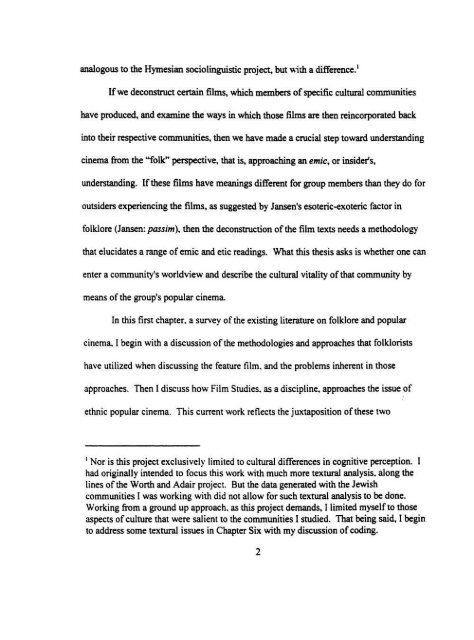Untitled - Memorial University of Newfoundland
Untitled - Memorial University of Newfoundland
Untitled - Memorial University of Newfoundland
You also want an ePaper? Increase the reach of your titles
YUMPU automatically turns print PDFs into web optimized ePapers that Google loves.
analogous to the Hymesian sociolinguistic project. but \\ith a difference. I<br />
Ifwe deconstruct certain films, which members <strong>of</strong>specific cultural communities<br />
have produced. and examine the ways in which those films are then reincotporated back<br />
into their respective communities., then we have made a crncial step toward understanding<br />
cinema from the '"folk" perspective. that is. approaching an emic, or insider's,<br />
understanding. lfthese films have meanings different for group members than they do for<br />
outsiders experiencing the films, as suggested by Jansen's esoteric-exoteric factor in<br />
folklore (Jansen: passim), then the deconstruction <strong>of</strong>the film texts needs a methodology<br />
that elucidates a range <strong>of</strong>emic and etic readings. What this thesis asks is whether one can<br />
enter a community's woridview and describe the cultural vitality <strong>of</strong>that community by<br />
means <strong>of</strong> the group's popular cinema<br />
In this first chapter. a survey <strong>of</strong>the existing literature on folklon: and popular<br />
cinema. I begin with a discussion <strong>of</strong>the methodologies and approaches that folklorists<br />
have utilized when discussing the feature film. and the problems inherent in those<br />
approaches. Then I discuss how film Studies. as a discipline. approaches the issue <strong>of</strong><br />
ethnic popular cinema. This current work refletts the juxtaposition <strong>of</strong> these two<br />
I Nor is this project exclusively limited to cultural differences in cognitive perception. I<br />
had originally intended to focus this work with much more textural analysis. along the<br />
lines <strong>of</strong>the WoMb and Adair project. But the data generated with the Jewish<br />
communities [ was working with did not allow for such textural analysis to be done.<br />
Working from a ground up approach. as this project demands. I limited myself to those<br />
aspects <strong>of</strong>cultw'e that were salient to the communities t studied. That being said. I begin<br />
to address some textural issues in Chapter Six with my discussion <strong>of</strong>coding.

















